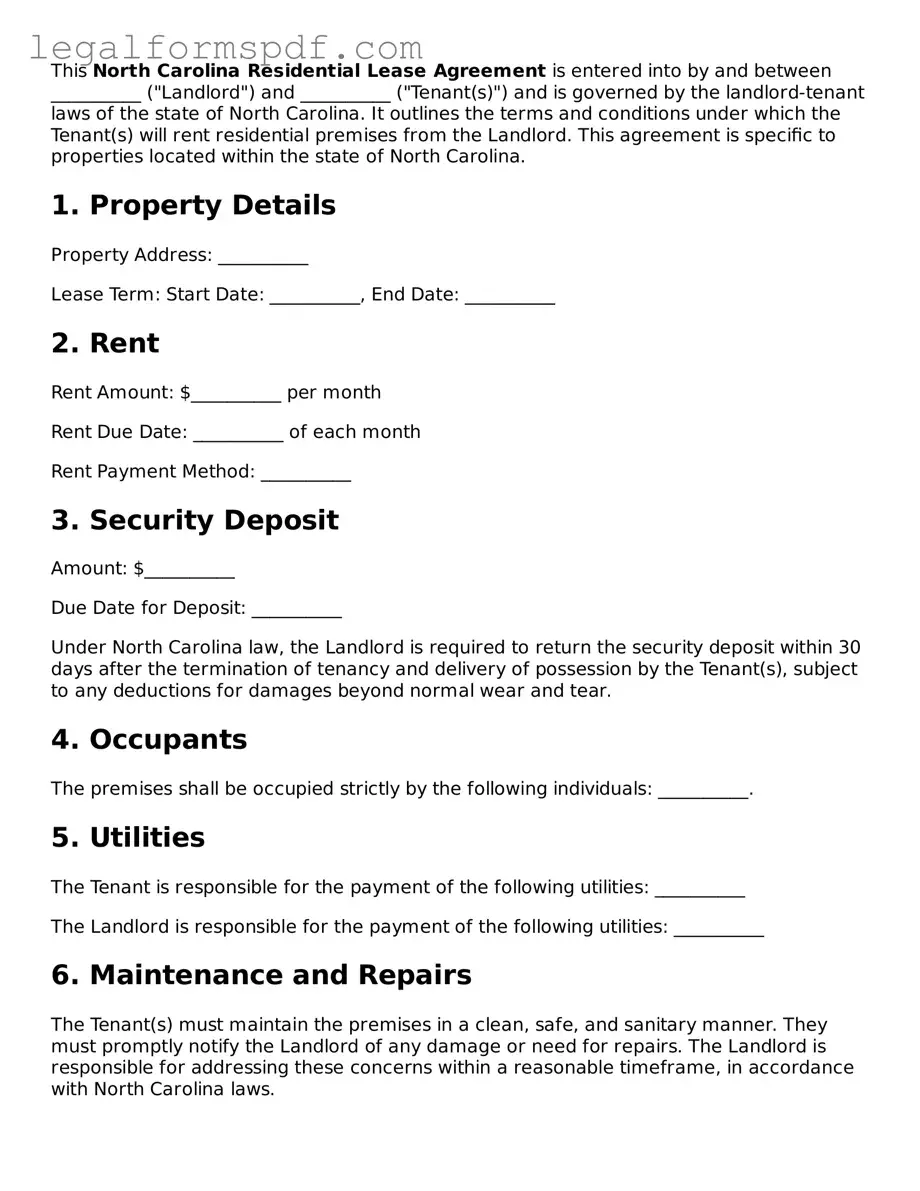What is a North Carolina Residential Lease Agreement?
A North Carolina Residential Lease Agreement is a legally binding document between a landlord and tenant that outlines the terms under which the tenant can rent a property from the landlord within the state of North Carolina. This agreement includes details such as the duration of the lease, monthly rent, security deposit, and the rights and responsibilities of both the landlord and tenant.
How do I know if my lease agreement complies with North Carolina laws?
To ensure your lease agreement complies with North Carolina laws, it should include specific terms and conditions mandated by state law, such as the handling of security deposits, the procedure for raising rent, and the rights and responsibilities of both parties regarding property maintenance. Consulting with a legal professional familiar with North Carolina's residential rental laws or referencing state statutes can help ensure compliance.
Can a lease agreement be oral in North Carolina?
While oral lease agreements are legally binding in North Carolina for terms of less than three years, they can lead to misunderstandings and disputes due to the lack of a written record. For clarity and legal protection, a written lease agreement is strongly recommended and is required for any leasing period of three years or longer.
What should be included in a North Carolina Residential Lease Agreement?
A comprehensive North Carolina Residential Lease Agreement should include the full names and contact information of the landlord and tenant, property address, lease term (start and end dates), monthly rent amount, security deposit details, policies regarding pets, maintenance responsibilities, and any other conditions or restrictions specific to the property or leasing arrangement.
Who needs to sign a North Carolina Residential Lease Agreement?
The property's landlord (or their legal representative) and all tenants over the age of 18 who will be residing in the property are required to sign the lease agreement. This ensures that all adults living in the rental unit are legally bound by its terms and conditions.
How can a tenant terminate a lease early in North Carolina?
To terminate a lease early in North Carolina, tenants should first review their lease agreement for any clauses that outline termination procedures and any penalties for early termination. If the lease agreement does not prohibit early termination, tenants may negotiate with their landlord to reach an agreement outside the lease terms. Under certain conditions, such as military service, state law may provide the right to terminate the lease early without penalty.
What happens if a tenant breaks a lease in North Carolina?
If a tenant breaks a lease in North Carolina without legal justification or without following the lease's outlined early termination procedures, they may be liable for the remaining rent due under the lease, as well as any other damages specified in the lease agreement or allowed under state law. Landlords are typically required to make reasonable efforts to re-rent the property to mitigate damages potentially owed by the tenant.
How are security deposits handled in North Carolina?
In North Carolina, security deposits are regulated by state law, which specifies maximum amounts, requires the deposit to be held in a trust account, and mandates that it be returned to the tenant within 30 days after lease termination, minus any costs for damages beyond normal wear and tear. Any deductions from the security deposit must be itemized in writing to the tenant.
Can a landlord enter the property without permission in North Carolina?
Landlords in North Carolina have the right to enter the rental property for certain purposes, such as emergencies, repairs, and inspections, but must typically provide the tenant with reasonable notice. The exact terms should be specified in the lease agreement. State law does not specify the exact amount of notice required, so it is important for the lease to clearly define this term.
What recourse does a tenant have if a landlord fails to make repairs?
If a landlord fails to make necessary repairs, tenants in North Carolina may have several options, depending on the lease terms and the severity of the issue. These might include repairing the issue and deducting the cost from the rent, paying less rent until the issue is resolved, or in severe cases, terminating the lease. Tenants taking such actions should be cautious to follow the proper procedures as outlined in their lease and North Carolina law to avoid legal repercussions.
